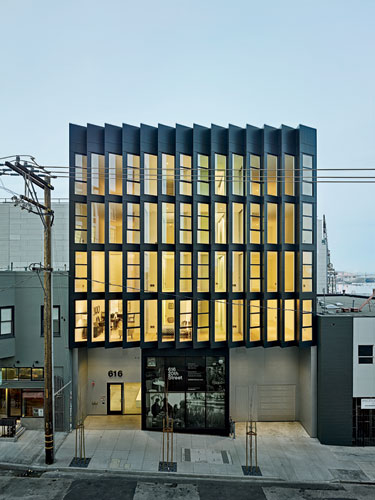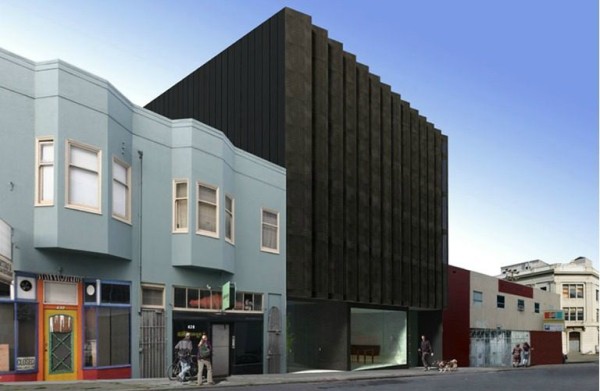
616 20TH in SoMa (40/40)
616 20th Street
Stanley Saitowitz/Natoma Architects

The formerly working-class neighborhood on the bay is now attracting an upper-middle class, owing to growth of the city’s tech and health-care industries since the 1990s. But the area is still dotted with Victorian cottages, along with a mix of old warehouses. “There are two competing scales,” notes Saitowitz, who wanted to meld the smaller domestic one with the repetitive masses of the industrial waterfront buildings. Nevertheless, the South African–born architect stayed within the modernist vocabulary of an architecture defined by its rigor, rationality, and economy of means. At 616 20th, a wood-frame structure sits atop a concrete base that contains 3,000 square feet of commercial space (still unoccupied) above a 10-car garage in the basement.
Saitowitz and three colleagues had originally purchased the 5,525-square-foot property to develop themselves. After he had designed it and got the various governmental approvals, the foursome decided to sell the project to Tipco Construction, which built it. Between October and December 2013, the two-bedroom condominiums sold out at an average of $775,00 per dwelling, not including two priced at a below-market rate to fulfill the city’s affordable-housing requirement. (These went for about $220,000 each.)


One reason the occupants responded so quickly to the design could be the plan’s efficiency—a Saitowitz trademark. One resident, Amir Azari, a marketing manager, says, “The plan is the best. It was marketed as a one-bedroom condo with a den, but [the den] can serve as a second bedroom because of the sliding doors.” For his part, Chila, an art director for an ad agency, says about his spare, high-design interiors, “I am a minimalist, and Stanley did a great job maximizing the space.” Sliding etched-glass pocket doors divide the bedrooms (or bedroom and den) from the living/dining area. At the core of each unit is the “pod,” consisting of an elongated kitchen facing the living/dining area and, behind it, the bathroom. Here a small corridor separates a closet at the rear of the kitchen from the linear bathroom, and internally connects one bedroom to the other room.
Whereas the facade’s sawtooth profile, oriented to the bay, helps expand the sense of space within the units facing south, the north elevation is sheathed in floor-to-ceiling panels of etched and clear glass. Clear-glass panels slide away to allow residents views of a planted courtyard in a nearby housing complex, as well as a garden terrace below. (Balustrades, also of glass, offer a sense of security to those who have seen Alfred Hitchcock’s Vertigo once too often.) Saitowitz inventively conformed to a city zoning regulation that requires 25 percent of the site to remain as open space by including the terrace and a stepped-back configuration on the upper floors of the building’s rear.
Although the market-rate, 820-square-foot, open-plan apartments are not conceived to accommodate most families, they appeal to the community of young professionals and artists seeking flexible living arrangements for varied households. And they suggest more affordable uses: recently Saitowitz adapted his condominium to a modular scheme for student rental apartments. Working with Nautilus Group, a private developer and builder, he has designed a prototype with five two-bedroom units of student housing in Oakland, near Mills College. After testing the waters with this project, now under construction, Nautilus will turn its attention to a five-stack complex of 80 two- and four-bedroom units near the University of California, Berkeley, campus. If all goes well, the essential goal of expanding the sense of space and light through a well-thought-out plan should remain intact in spite of economic differences between the two forms of housing.
Architect:
STANLEY SAITOWITZ │ NATOMA ARCHITECTS INC.
1022 Natoma Street No. 3
Francisco, California 94103
T. 415.626.8977 X 102
F. 415.626.8978
Size: 23,000 square feet
Construction Cost: withheld
Completion date: October 2013
